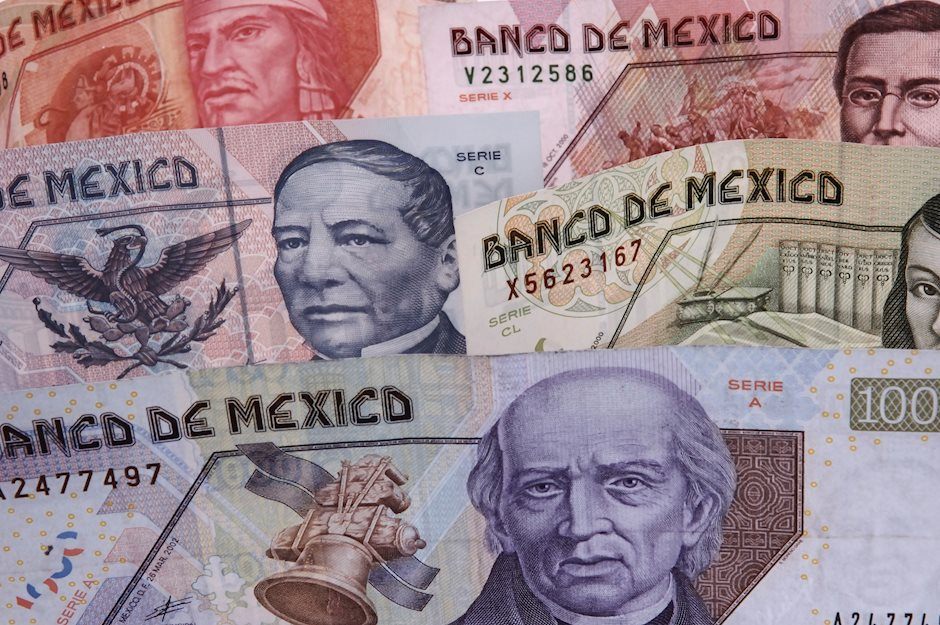Mexican Peso rebounds post US CPI, traders eye Banxico’s decision
- Mexican Peso finds its foot after US inflation data announced ahead of Banxico decision.
- US inflation report meets forecasts, raising chances of a Fed rate cut in December to 82%.
- Banxico expected to reduce rates to 10.25%, potentially narrowing the interest rate differential with the US.

The Mexican Peso advances against the US Dollar during the North American session on Wednesday as investors digested the latest US inflation report. Alongside that, traders braced for the Bank of Mexico (Banxico) monetary policy decision on Thursday, expecting the central bank will slash rates. At the time of writing, the USD/MXN trades at 20.50, down 0.27%.
US inflation data in October was in line with analysts’ expectations. Therefore, investors became optimistic that the Federal Reserve (Fed) could lower interest rates by 25 basis points at the December meeting. According to CME FedWatch Tool data, odds for a rate cut increased from 58% a day ago to 82% at the time of writing.
On Thursday, Banxico is expected to cut rates from 10.50% to 10.25%, according to 19 of 20 analysts polled by Reuters. This would reduce the interest rate differential between Mexico and the US, implying that USD/MXN could rise and challenge the year-to-date (YTD) peak at 20.80.
Aside from this, the risk appetite remains fragile after US President-elect Donald Trump named two China hawks to his cabinet. Rumors that Mike Waltz was appointed as National Security Advisor and Marco Rubio as Secretary of State would toughen the US posture against China but also against Mexican drug cartels and illegal immigration.
Meanwhile, Minneapolis Fed President Neel Kashkari crossed the wires. He stated the Fed would need additional rate cuts, adding, “I think inflation is heading in the right direction and have confidence in that.”
Last, Dallas Fed President Lorie Logan added that the US central bank “most likely” needs to reduce its restrictive policy, though it must proceed cautiously. She added it's challenging to know how many cuts are needed and how soon they need to happen.
Ahead this week, Mexico’s economic docket will feature the Banxico policy decision. On the US front, Fed speakers, inflation on the producer side, and Retail Sales will help dictate the USD/MXN pair’s direction.
Daily digest market movers: Mexican Peso steadies against US Dollar
- The USD/MXN remains steady, despite the fact that the US Dollar Index (DXY), which tracks the performance of the American currency against another six, climbs to a seven-month high of 106.39, up by over 0.40%.
- In October, the US Consumer Price Index (CPI) rose as expected to 2.6% YoY, up from 2.4%. On a monthly basis, the CPI rose by 0.2% as foreseen.
- The Core CPI expanded by 3.3% YoY, as projected, and 0.3%, as estimated by private analysts.
- Data from the Chicago Board of Trade, via the December fed funds rate futures contract, shows investors estimate 23 bps of Fed easing by the end of 2024.
USD/MXN technical outlook: Mexican Peso counterattacks as USD/MXN hovers around 20.55
The USD/MXN upward bias remains, even though the pair has failed to re-test weekly highs seen at 20.69. Once surrendered, the next resistance would be the year-to-date (YTD) high of 20.80 on November 6. If surpassed, the next resistance would be the psychological 21.00 figure, followed by the March 8, 2022 peak at 21.46.
Conversely, sellers must push the exchange rate below 20.50, so they can remain hopeful of driving the spot to the 20.00 figure. A breach of the latter will expose the 50-day Simple Moving Average (SMA) at 19.73, followed by the psychological figure at 19.50 and the October 14 low of 19.23.
Mexican Peso FAQs
The Mexican Peso (MXN) is the most traded currency among its Latin American peers. Its value is broadly determined by the performance of the Mexican economy, the country’s central bank’s policy, the amount of foreign investment in the country and even the levels of remittances sent by Mexicans who live abroad, particularly in the United States. Geopolitical trends can also move MXN: for example, the process of nearshoring – or the decision by some firms to relocate manufacturing capacity and supply chains closer to their home countries – is also seen as a catalyst for the Mexican currency as the country is considered a key manufacturing hub in the American continent. Another catalyst for MXN is Oil prices as Mexico is a key exporter of the commodity.
The main objective of Mexico’s central bank, also known as Banxico, is to maintain inflation at low and stable levels (at or close to its target of 3%, the midpoint in a tolerance band of between 2% and 4%). To this end, the bank sets an appropriate level of interest rates. When inflation is too high, Banxico will attempt to tame it by raising interest rates, making it more expensive for households and businesses to borrow money, thus cooling demand and the overall economy. Higher interest rates are generally positive for the Mexican Peso (MXN) as they lead to higher yields, making the country a more attractive place for investors. On the contrary, lower interest rates tend to weaken MXN.
Macroeconomic data releases are key to assess the state of the economy and can have an impact on the Mexican Peso (MXN) valuation. A strong Mexican economy, based on high economic growth, low unemployment and high confidence is good for MXN. Not only does it attract more foreign investment but it may encourage the Bank of Mexico (Banxico) to increase interest rates, particularly if this strength comes together with elevated inflation. However, if economic data is weak, MXN is likely to depreciate.
As an emerging-market currency, the Mexican Peso (MXN) tends to strive during risk-on periods, or when investors perceive that broader market risks are low and thus are eager to engage with investments that carry a higher risk. Conversely, MXN tends to weaken at times of market turbulence or economic uncertainty as investors tend to sell higher-risk assets and flee to the more-stable safe havens.
Author

Christian Borjon Valencia
FXStreet
Christian Borjon began his career as a retail trader in 2010, mainly focused on technical analysis and strategies around it. He started as a swing trader, as he used to work in another industry unrelated to the financial markets.

















